

Animals Bow to Their Mechanical Overlords - Issue 10: Mergers & Acquisitions. Several years ago, a group of American cockroaches discovered four strangers in their midst.
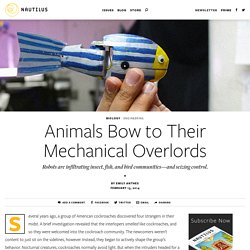
A brief investigation revealed that the interlopers smelled like cockroaches, and so they were welcomed into the cockroach community. The newcomers weren’t content to just sit on the sidelines, however. Instead, they began to actively shape the group’s behavior. Nocturnal creatures, cockroaches normally avoid light. Festo. Flying Spherical Robot Gimball Collides With Objects, But Keeps On Flying. 3-D Printed Octopus Suckers Help Robots Stick. Four small 3-D printed robot suckers and two larger ones; image courtesy of Doug LaFon, U.S. Army Research Laboratory photographer Legions of animal-inspired robots are being created to improve military missions and disaster response efforts—from crawling cockroach-like RHex bots to leaping Sand Flea robots and the speeding Cheetah machines. Now, a squishier source for smart robo-tech has joined the ranks: octopuses . Cockroaches could inform robotics. ANN ARBOR—Running cockroaches start to recover from being shoved sideways before their dawdling nervous system kicks in to tell their legs what to do, researchers have found.
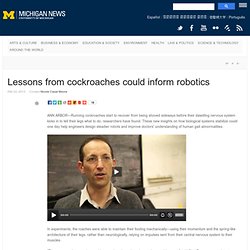
These new insights on how biological systems stabilize could one day help engineers design steadier robots and improve doctors' understanding of human gait abnormalities. In experiments, the roaches were able to maintain their footing mechanically—using their momentum and the spring-like architecture of their legs, rather than neurologically, relying on impulses sent from their central nervous system to their muscles.
"The response time we observed is more than three times longer than you'd expect," said Shai Revzen, an assistant professor of electrical engineering and computer science, as well as ecology and evolutionary biology, at the University of Michigan. Revzen is the lead author of a paper on the findings published online in Biological Cybernetics. It will appear in a forthcoming print edition. Related Links: One Per Cent: Cardboard cockroach ranks among world's fastest robots. Sara Reardon, reporter Don't stomp on this little robot - not yet, anyway.

VELOCIRoACH, a small cardboard hexapod modelled on a cockroach, can run at 2.7 metres per second, placing it among the fastest robots in the world. Robot bees designed to take over for declining bee populations in 2015. Ant executions serve a higher purpose, research shows. Natural selection can be an agonizingly long process.

Some organisms have a way of taking matters into their own hands, or—in the case of the ant species Cerapachys biroi—mandibles. Researchers at The Rockefeller University and Paris University have found that when a C. biroi ant steps out of line and attempts to lay eggs when it shouldn't, the other ants will drag it out of the nest and bite and sting it until it dies. And in a new study published this month in Current Biology, they believe they've discovered why. Rather than being a competitive behavior between ants over who gets to reproduce more, it appears the killing is a means of keeping the whole colony functioning properly. It's a mechanism, the researchers say, that parallels processes in other areas of biology, even inside a single individual—like when the body attacks cancer cells proliferating out of control.
Robot able to swim, crawl and walk. Salamandra robotica II is a last generation amphibious robot developed by the Biorobotics Laboratory at EPFL (École Polytechnique Fédérale de Lausanne).
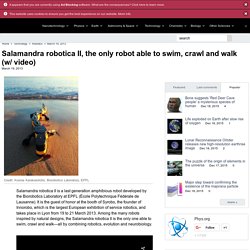
It is the guest of honor at the booth of Syrobo, the founder of Innorobo, which is the largest European exhibition of service robotics, and takes place in Lyon from 19 to 21 March 2013. Among the many robots inspired by natural designs, the Salamandra robotica II is the only one able to swim, crawl and walk—all by combining robotics, evolution and neurobiology. Share Video undefined A salamander's locomotion is controlled by neural circuits distributed along its spinal cord. This amphibious robot was developed by Professor Auke Ijspeert's team at EPFL in collaboration with Jean-Marie Cabelguen from the University of Bordeaux /INSERM.
It is a valuable tool for better understanding of locomotion systems and their associated pathologies. Explore further: EPFL robots will soon appear in school classrooms. Scientists study some fishy behavior to solve an animal locomotion mystery. Video: Stability, maneuverability in knifefish Related Articles Noah Cowan is taking an innovative approach to improving robotics We can't talk with the animals.
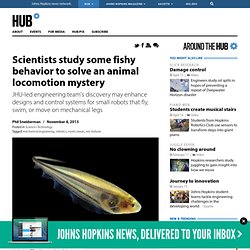
A fish that pushes in the wrong direction solves a mystery of animal locomotion. 7-Nov-2013 [ Print | E-mail ] Share [ Close Window ] Contact: Tanya Klein 973-596-3433New Jersey Institute of Technology For nearly 20 years, Professor Eric Fortune has studied glass knifefish, a species of three-inch long electric fish that lives in the Amazon Basin.
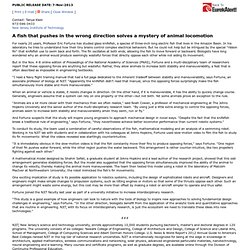
In his laboratory he tries to understand how their tiny brains control complex electrical behaviors. But in the Nov. 4-8 online edition of Proceedings of the National Academy of Sciences (PNAS), Fortune and a multi-disciplinary team of researchers report that these opposing forces are anything but wasteful. Robo-pets may contribute to quality of life for those with dementia. Robotic animals can help to improve the quality of life for people with dementia, according to research.

Companionable robots are enjoyable, interesting and can be used as an intervention to promote social interaction. Northumbria University’s Professor Glenda Cook has carried out ethnographic work in care homes in North East England introducing PARO – a robotic harp seal – to residents.